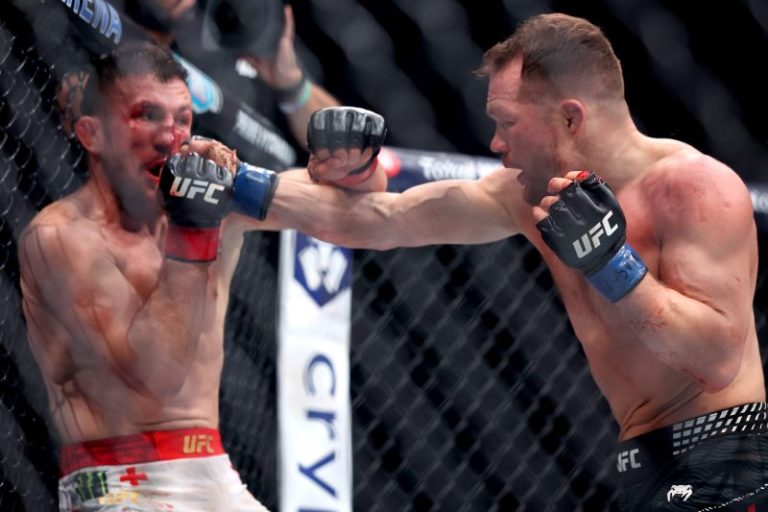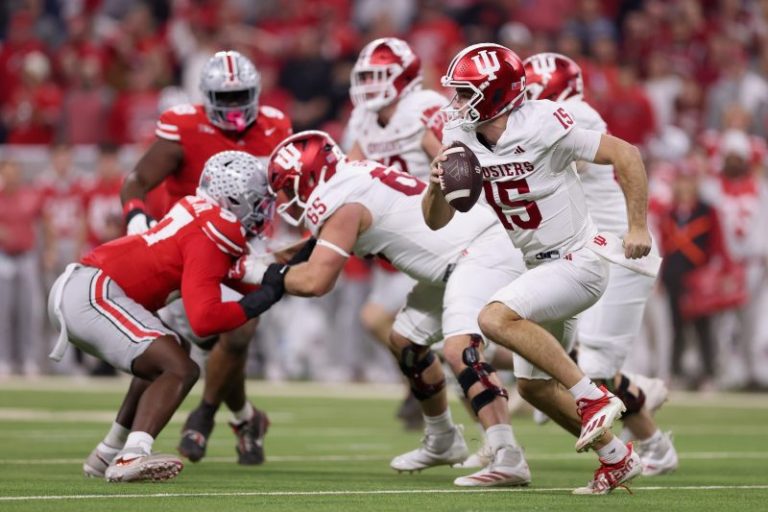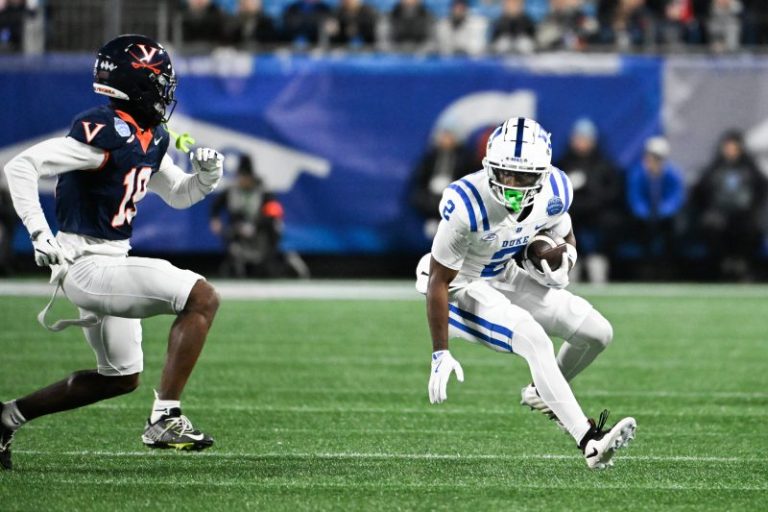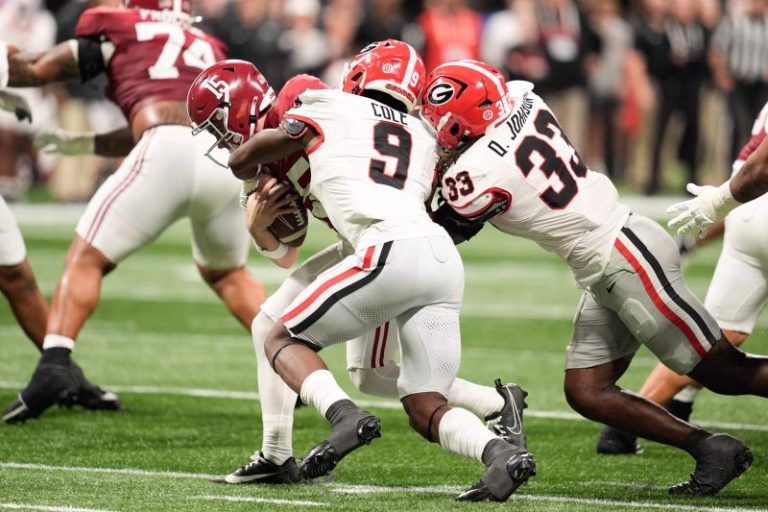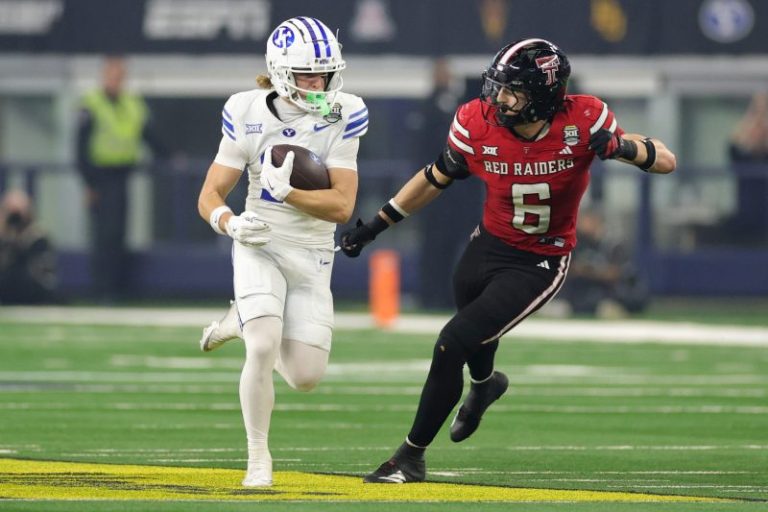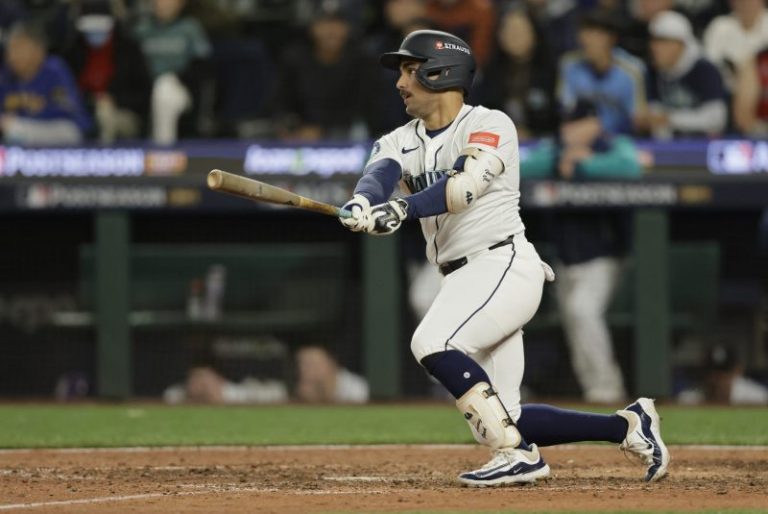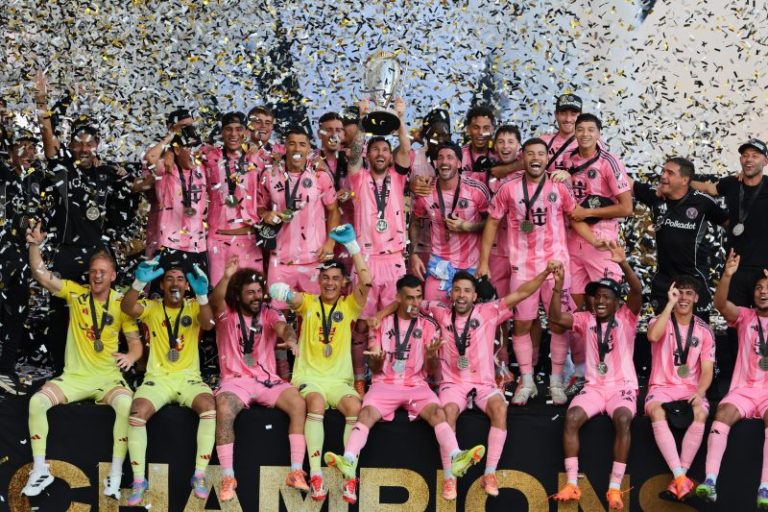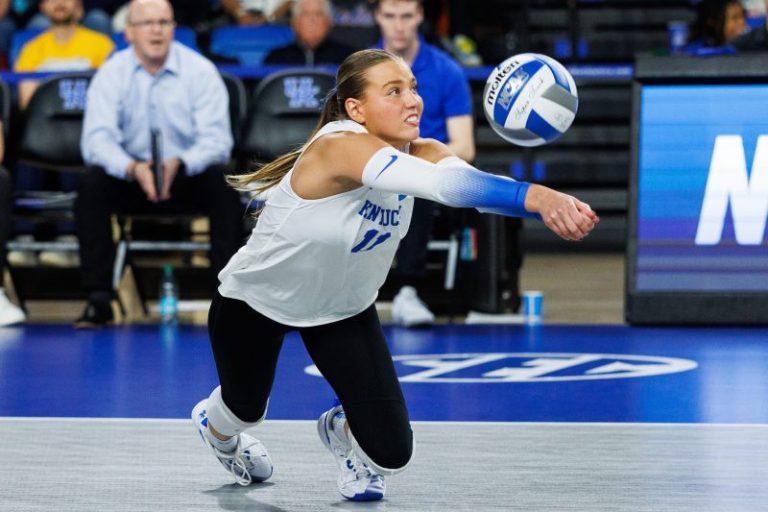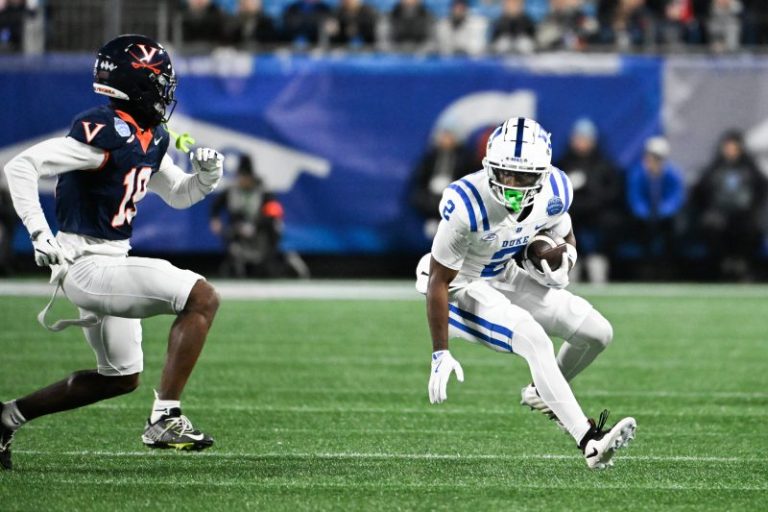The domination has ended for Merab Dvalishvili.
In shocking fashion, Dvalishvili lost to Petr Yan by unanimous decision in a bantamweight title bout at UFC 323, ending Dvalishvili’s championship reign atop the 135-pound division and his 14-bout winning streak.
Dvalishvili, a 34-year-old Georgian, had not lost a fight since 2018 during a run that included three title defenses.
But a rematch with Yan derailed it all.
The two men fought first in 2023, when Dvalishvili won by unanimous decision. But this time, in the rematch, Yan punished Dvalishvili with his fists, kicks and even takedowns. He also showed remarkable defense in fending off most of Dvalishvili’s takedown attempts.
The judges scored it 49-46, 49-46, 48-47 in favor of Yan.
“I feel very happy. I worked so hard,’’ Yan said through an interpreter after the five-round fight. “I prepared so hard for this moment.’’
Dvalishvili’s face, bloodied and battered, also demonstrated the pain Yan inflicted.
Yan, the 32-year-old Russian, improved to 20-5 (12-4 UFC) after winning his fourth fight in a row.
Dvalishvili’s record dropped to 21-5 (14-3 UFC).
Dvalishvili said he was trying to make it an entertaining fight by standing toe-to-toe with Yan, “and he was a better fighter today.’’
Moments after Yan was awarded the championship belt, Dvalishvili also said, “Congratulations to him, but I want a rematch.’’
USA TODAY Sports provided round-by-round analysis for the Dvalishvili-Yan fight and the rest of the main card:
Petr Yan def. Merab Dvalishvili by unanimous decision: Round-by-round analysis
Round 1
Petr Yan entered the octagon and turned a cartwheel. No telling how that flair might serve him now that Merab Dvalishvili has entered the octagon, too, with the fight set to begin.
Merab on the move, and Yan shadowing. Merab lets fly with a right and lands a right overhand. Yan taking his time. Eats another right from Merab, and he better start punching soon. Merab showing aggression.
Merab charges forward and unloads as Yan looks mostly concerned about covering up. Yan connects with a couple of jabs and Merab throws heavy punches, mostly missing. Yan connects with a big right! Then a left. But Merab scores a takedown, and he needs to wrap up Yan. Yan clearly has the ability to turn Merab, but not if he’s wrapped up. Yan fighting the takedown and getting kneed in the glutes and squirms loose. But Merab wraps up Yan again and attempts another takedown. Fans boo. Dvalishvili 10, Yan 9
Round 2
Merab rushes out behind a big right. He’s remained the aggressor and looks for another takedown. Yan defending well and Merab determined to score this takedown. But Yan breaks free.
Yan connects with a jab. A hard jab. Merab lunges. Reportedly, Merab has failed to score any takedowns. Unreal. Now, Yan scores the takedown! Then Merab pulls the reversal! And Yan reverses Merab!
They’re clinched on the fence but Yan is in a headlock. Now they shake loose. Yan scores with another wicked jab. Merab is keeping Yan tied up and gains a reprieve from Yan’s fists. Yan scores with a right. Merab’s face is badly bloodied. Dvalishvili 20, Yan 18
Round 3
Merab’s nose looks like it might be broken. No question it’s bloody and battered. Merab lands a hard right and Yan scores a big takedown. Merab on the rampage but Yah slugs him square in he face.
Merab slings Yan over his shoulder, slams him to the mat and back up pops Yan. They’re trading blows, but both look exhausted. Merab attempts a takedown and Yan fights it off.
Yan lands a right and then a jab. Merab goes for yet another takedown. More terrific takedown defense by Yan. Merab charging ahead. Yan lands a vicious kick to the body. Merab is hurt. Dvalishvili 29, Yan 28
Round 4
Yan opens with a hard low leg kick. Merab shows no ill effects from that kick to the abdomen. Yet. He’s attempting yet another takedown and gets taken down instead.
Merab going for a choke here. Yan shakes free of the submission attempt and now has Merab’s back. Yan lands a kick and he’s on the move. Merab stays aggressive. Another takedown attempt and Yan defends again.
Yan landing with that jab repeatedly and scores with another hard left shot to the body. Another hard body shot by Yan. Yan pounds Merab with a vicious left, and then a big right followed by an elbow. Yan is taking over. Dvalishvili 38, Yan 38
Round 5
Yan comes out assertively with side kicks to the legs. Merab firing punches and Yan responds with a leg kick. Now he scores with a left hook to Merab’s body. They trade big punches, and Yan appears to get the best of the exchange.
Yan lands a couple of lefts. He looks patient and dangerous. Merab wraps up Yan but Yan fights him off YET again! Blood is everywhere – mostly Merab’s. Merab’s face is a bloody mess. He’s firing punches but doesn’t look certain about what he wants to do. Now he’s looking for a submission.
Yan shakes free and gets on top. He scores with a knee and elbow before they separate. Yan lands another crushing body kick. Crowd cheering, clock running out and Yan scores his fifth takedown of the fight! Yan 48, Dvalishvili 47
Joshua Van def. Alexandre Pantoja by TKO
The fight lasted 26 seconds, and it was as shocking as it was excruciating.
At 24, Van becomes the second youngest champion in UFC history after Pantoja appeared to seriously injure his arm just as the flyweight bout was getting underway.
Pantoja, 35, attempted a head kick and Van caught his left. That left Pantoja spinning and looking for a place to land.
But as he fell, Pantoja landed on his left arm and it didn’t look good. He made it clear he couldn’t continue and the referee halted the fight. Dana White said afterward that Pantoja had suffered a shoulder injury.
The only younger champion in UFC history was Jon Jones, who won his first belt at 23.
Van improved to 16-2 and Pantoja fell to 30-6.
Alexandre Pantoja vs. Joshua Van: Round-by-round analysis
Round 1
Flyweight champion Alexandre Pantoja already looks like one of the best ever to fight in the division. But 24-year-old contender Joshua Van looks to change the narrative with a massive upset.
Pantoja opens with a leg kick and the punches already are flying. Pantoja suffers an arm injury and the fight is over! Pantoja cannot continue!
Tatsuro Taira def. Brandon Moreno by TKO
Taira proved to be a quicker learner in his victory over Moreno in the flyweight bout.
Taira spent most of the first round fighting off a possible submission after trying to take down Moreno but slipping into Moreno’s clutches.
Taira took Moreno down again in Round 2 and he kept him there – long enough to pound him with punches before the referee halted the fight.
Taira, the 25-year-old from Japan, improved to 18-1. Moreno, the 31-year-old from Mexico, fell to 23-9-2.
Brandon Moreno vs. Tatsuro Taira: Round-by-round analysis
Round 1
Brandon Moreno, the former two-time UFC flyweight champion, is looking to fight for the title again. The path leaves him face-to-face with Tatsuro Taira.
Taira opens with a fast right that misses the target – violently. Taira attempts a takedown but Moreno ends up on top and is locking in a body triangle. Taira looks helpless but not in danger of submitting. The problem: 2:45 left to go and no clear exit for Taira.
Taira starts to throw punches, but there’s not much room to operate. The hold is weakening and the fans boo. But Moreno is retightening the triangle. Taira throwing punches, so clearly he’s getting adequate air and the crowd is losing patience. Taira breaks free and fails to score before the round ends. Moreno 10, Taira 9
Round 2
Moreno scores with a jab and a right hook. Moreno fires another jab and connects with a low leg kick. Connects with another left. Taira looks … a little unsure of himself. Now he unloads with punches and scores a takedown.
Taira now throwing hard punches to Moreno’s head and face. A flurry of big punches and the referee stops the fight! It’s over! It’s Taira by TKO.
Payton Talbott def. Henry Cejudo by unanimous decision
Talbott knocked off the legendary Cejudo and had a message after winning the flyweight bout by unanimous decision. A fight that sent Cejudo back into retirement.
“Guys, give it up for Henry Cejudo, the savior of the flyweight division,’’ Talbott said. “Love him or hate him, everyone watched.’’
It was riveting theater again, as the 38-year-old Cejudo brawled with the 27-year-old Talbott. He had the heart of a champion – a former Olympic gold medalist wrestler and former two-division UFC champion (flyweight and bantamweight).
But Talbott was too good and too young on a night that ended with Cejudo’s face covered with blood and pride. Talbott improved to 11-1 and Cejudo fell to 16-6.
Henry Cejudo vs. Payton Talbott: Round-by-round analysis
Round 1
Legend Henry Cejudo hasn’t looked so legendary while losing his last three fights. Can he avoid yet another loss against 27-year-old Payton Talbott?
Cejudo opens with a couple quick low leg kicks. Talbott lands a huge right. But Cejudo marches forward and lands another low leg kick. Talbott lands another left as Cejudo keeps firing those low leg kicks. Talbott noticeably taller. But nothing new for Cejudo.
Cejudo bleeding from the nose and now he’s getting kneed and Talbott lands a left. Cejudo drops Talbott with a right but Talbott quickly back up. And Talbott has tattooed Cejudo’s face and then scores a takedown. In fact, sticks out his tongue in celebration. Talbott scores with a couple of elbows and lands a flurry of shots before Cejudo scrambles to his feet. And Talbott takes him down again HARD seconds before the round ends. Talbott 10, Cejudo 9
Round 2
Talbott drops Cejudo with a right but he quickly scrambles to his feet and now Cejudo is on top! The former Olympic gold medalist wrestler, of course. Cejudo on top but not throwing punches, maybe just catching his breath? Crowd growing restless.
About three minutes left. How will Cejudo use the time? Talbott scrambles to his feet, but Cejudo still has his back. Now they’re separated and Talbott is firing punches and clips Cejudo with a stiff left. Talbott is pouring it on!
Cejudo fighting back and it’s a bloody war. Cejudo a bloody mess but still fighting. Cejudo’s left eye just covered with blood. Round ends. Incredible. Talbott 20, Cejudo 18
Round 3
Cejudo scores with a hard low leg kick. And now he’s firing punches and kicks. Talbott knees Cejudo and he just looks sharper and fresher. Cejudo has no answer for the long limbs that have bloodied his face.
Now they’re clinched. Cejudo’s right eye bleeding again as they’re clinched. Talbott drives his knee into Cejudo’s body but suddenly Cejudo scores the takedown. Talbott quickly back on his feet. Talbott drive his knee into Cejudo’s chest and it’s getting ugly.
Cejudo attempts another takedown but Talbott fends it off. Hard to know who’s wearing whose blood. Talbott pouring it on, but Cejudo swinging for the fences, too. Talbott points to the center of the mat and they brawl as the final seconds elapse. Talbott 30, Cejudo 27
Jan Blachowicz vs. Bogdan Guskov declared majority draw
It’s almost impossible to imagine the 42-year-old Blachowicz reigning atop the light heavyweight division again. But retirement doesn’t appear to be imminent, either.
Despite suffering a beating in the second round, Blachowicz rallied and earned a majority draw against Guskov.
He weathered a flurry of Guskov’s elbows and fists after getting dropped in the second round, then fought his way back in the three-round bout behind an aggressive, jab-heavy attack.
One judge scored it 29-28 for Blachowicz and the two other judges scored it 28-28 – meaning they scored the second round 10-8 in favor of Guskov but gave the first and third rounds to Blachowicz.
Jan Blachowicz vs. Bogdan Guskov: Round-by-round analysis
Round 1
Jan Blachowicz, the former light heavyweight champion, enters this fight having won just one of his last five bouts. At 42, can he get back on track against 33-year-old Bogdan Guskov?
Fighters circling, measuring. Guskov throws a few jabs, not with any serious intention. Blachowicz connects with a low leg kick, tries to follow up with a jab that falls short. Waiting for violence to ensue. Blachowicz scores with a jab and connects with another low level kick. Another kick. But no one is going for broke yet.
Guskov connects with a straight left that backed up Blachowicz. But Blachowicz responds with a couple of lefts. They traded kicks. Jabs are ruling this round. The crowd is getting a little restless. Now whistling ensues. Blachowicz has pounded Guskov’s left leg, but he lands a flurry of punches. Blachowicz 10, Guskov 9
Round 2
Blachowicz sticks Guskov with a solid left and connects with another leg kick. Then Guskov scores with a big right and down goes Blachowicz as Guskov begins the ground and pound and tries to finish the job. Guskov connects with two more big shots.
Blachowicz has Guskov in a heel locker but he breaks free. Lots of time left as Guskov sets up for more ground and pound. Blachowicz taking lots of punishment as Guskov throws elbows and opens up a cut on Blachowicz’s right eye.
Guskov in total control and Blachowicz winces as the punishment continues. Blachowicz punching back, but with no authority. Guskov capitalizing with sharp elbows. Blachowicz 19, Guskov 19
Round 3
Blachowicz comes out with surprising assertiveness, but Guskov scores with a left jab that rattles Blachowicz. Guskov connecting with big shots. Blachowicz still stalking at times and showing some energy. Throwing impressive jabs, but Guskov fires back with a hard right.
Blachowicz is revving up and fires away despite blood running into his left eye. Guskov retreating and growing strangely apprehensive. It’s Blachowicz who’s fighting with more aggressiveness.
They’re at the center of the octagon. Blachowicz knocks Guskov down with a right as the round comes to a close! Unbelievable! Blachowicz 29, Guskov 28
UFC 323 results: Prelims
Manuel Torres def. Grant Dawson by TKO (1st round), lightweight
Chris Duncan def. Terrance McKinney by submission (anaconda choke, 1st rd), lightweight
Maycee Barber def. Karine Silva by unanimous decision, women’s flyweight
Fares Ziam def. Nazim Sadykhov by TKO (2nd rd), lightweight
UFC 323 results: Early Prelims
Brunno Ferreira def. Marvin Vettori by unanimous decision, middleweight
Jalin Turner def. Edson Barboza by TKO (1st rd), lightweight
Iwo Baraniewski def. Ibo Aslan KO (1st rd), light heavyweight
Mansur Abdul-Malik def. Antonio Trocoli by submission (guillotine choke/1st rd), middleweight
Mairon Santos def. Muhammad Naimov by TKO (3rd rd), featherweight
UFC 323 predictions: Dvalishvili vs. Yan expert picks
Sporting News: Merab via unanimous decision
Daniel Yanofsky writes: ‘Has Yan improved his takedown defense (85%) since the last fight? Even against other opponents, they aren’t on the same level as Merab. Even if injuries may have affected Yan last time, it appears nothing can stop Merab, especially on the floor. Expect the same result here.’
Action Network: Merab Dvalishvili
Billy Ward writes: ‘With the champion only about two years older than the challenger, it’s also hard to say that time could be the equalizer here, as both men are in roughly the same stage of their careers. For all of those reasons, the roughly four-to-one odds on ‘The Machine’ to retain his title feel about right.’
Score and Stats: Merab Dvalishvili
Rick Rockwell writes: ‘You can throw caution to the wind and bet on a KO upset, but I don’t see it happening. Merab wins with defense, timing, pacing, and suffocating wrestling. Yan didn’t have an answer for that in 2023, and he won’t have an answer for it now.’
UFC 323 odds: Dvalishvili vs. Yan fight
Odds via BetMGM as of Thursday.
Merab Dvalishvili (-500) vs. Petr Yan (+340); For bantamweight title
UFC 323: Dvalishvili vs. Yan fight card
Fight card according to ESPN:
Fight card according to ESPN.
Main Card:
Merab Dvalishvili vs. Petr Yan; For bantamweight title
Alexandre Pantoja vs. Joshua Van; For flyweight title
Brandon Moreno vs. Tatsuro Taira; Flyweight
Henry Cejudo vs. Payton Talbott; Lightweight
Jan Blachowicz vs. Bogdan Guskov; Bantamweight
Prelims:
Grant Dawson vs. Manuel Torres; Lightweight
Chris Duncan vs. Terrance McKinney; Lightweight
Maycee Barber vs. Karine Silva; Women’s flyweight
Nazim Sadykhov vs. Fares Ziam; Lightweight
Early Prelims:
Marvin Vettori vs. Brunno Ferreira; Middleweight
Edson Barboza vs. Jalin Turner; Lightweight
Ibo Aslan vs. Iwo Baraniewski; Light Heavyweight
Mansur Abdul-Malik vs. Antonio Trocoli; Middleweight
Muhammad Naimov vs. Mairon Santos; Featherweight
UFC 323 preliminary and main card start times
Here are your start times.
Early Prelims: 6 p.m. ET (FX, ESPN+, Disney+)
Prelims: 8 p.m. ET (ESPN2, FX, ESPN+, Disney+)
Main card: 10 p.m. ET (PPV on ESPN+)
UFC 324 moves to Paramount+, ending PPV era for UFC
After UFC 323, the organization now moves on from its PPV model with ESPN and ESPN+. With its seven-year, $7.7 billion deal with Paramount, the promise is upwards of 40 UFC events a year. It all begins in 2026 with UFC 324 on Jan. 24, which will broadcast on streaming service Paramount+.
UFC 323 odds: Merab Dvalishvili vs Petr Yan full card
Fight card according to ESPN: Odds via BetMGM as of Thursday.
Main Card:
Merab Dvalishvili (-500) vs. Petr Yan (+340); For bantamweight title
Alexandre Pantoja (-265) vs. Joshua Van (+200); For flyweight title
Brandon Moreno (+110) vs. Tatsuro Taira (-140); Flyweight
Henry Cejudo (+200) vs. Payton Talbott (-265); Lightweight
Jan Blachowicz (-140) vs. Bogdan Guskov (+110); Bantamweight
Prelims:
Grant Dawson (-235) vs. Manuel Torres (+180); Lightweight
Chris Duncan (-195) vs. Terrance McKinney (+150); Lightweight
Maycee Barber (-180) vs. Karine Silva (+140); Women’s flyweight
Nazim Sadykhov (+115) vs. Fares Ziam (-145); Lightweight
Early Prelims:
Marvin Vettori (-120) vs. Brunno Ferreira (-110); Middleweight
Edson Barboza (+200) vs. Jalin Turner (-265); Lightweight
Ibo Aslan (+165) vs. Iwo Baraniewski (-215); Light Heavyweight
Mansur Abdul-Malik (-1000) vs. Antonio Trocoli (+560); Middleweight
Muhammad Naimov (+220) vs. Mairon Santos (+295); Featherweight
Ring walk time for Dvalishvili and Yan main event
The Merab Dvalishvili and Petr Yan fight card consists of 14 fights and will begin at 6 p.m. ET on Saturday, December 6, 2025, with early prelim fights. The main event for the Dvalishvili vs Petr Yan fight is expected to be around 11:30 p.m. ET. However, the duration of the undercard will impact the actual start.
Where is UFC 323: Dvalishvili vs Yan?
UFC 323: Merab Dvalishvili vs Petr Yan will be held at the T-Mobile Arena in Las Vegas on Saturday, Dec. 6, 2025.
UFC 323 live stream
The Merab Dvalishvili and Petr Yan prelims and early prelims fights will be available to stream on ESPN+ and Disney+, while the main card will be streamed on ESPN Pay-Per-View.
UFC 323 price
UFC events are available to ESPN+ subscribers. The cost of the service is $10.99 a month or $109.99 for the year. The PPV is available for an additional $79.99.

